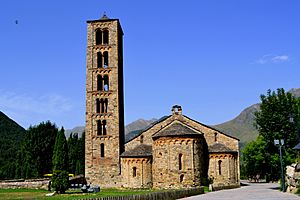Sant Climent, Taüll facts for kids
Quick facts for kids Saint Clement of Taüll |
|
|---|---|
|
Sant Climent de Taüll
|
|

Sant Climent de Taüll
|
|
| Religion | |
| Affiliation | Roman Catholic |
| Ecclesiastical or organizational status | Parish church |
| Location | |
| Location | Taüll, Catalonia, Spain |
| Architecture | |
| Architectural type | Church |
| Architectural style | Romanesque |
| Official name: Catalan Romanesque Churches of the Vall de Boí | |
| Type | Cultural |
| Criteria | ii, iv |
| Designated | 2000 (24th session) |
| Reference no. | 988 |
| Region | Europe and North America |
Sant Climent de Taüll (pronounced like "San Klee-ment day Tah-ool"), also known as the Church of St. Clement of Tahull, is a very old church in Catalonia, Spain. It's a great example of Romanesque architecture, which was a popular building style a long time ago. You can also see influences from Lombard and Byzantine styles in its design.
The church has a special shape called a basilica plan. This means it has three long sections inside, called naves. Big columns separate these sections. Each section ends with a rounded part called an apse. Next to the church, there's a tall, thin bell tower with six floors. Inside, you can find amazing old paintings by an artist known as the Master of Taüll. There's also a wooden altar. The most famous painting, showing Christ in Majesty, was moved to a museum in Barcelona.
History of the Church
Sant Climent de Taüll is located in a village called Taüll. This village is in the Valley of Boí, in the province of Lleida, Catalonia, Spain. We don't know the exact year the church was built. However, we do know it was officially opened and blessed on December 10, 1123.
Before the church was built, the land it stands on was bought and sold by different noble families. Guillem Ramon, who was a bishop, blessed Sant Climent de Taüll. The very next day, he also blessed another Romanesque church nearby, called Santa Maria de Taüll.
The church's design shows a strong Lombard influence, especially in its outside decorations. The tall bell tower, which stands out, shows Byzantine influence. Sant Climent de Taüll was built as a place for Christian worship. This was different from some other churches of that time, which were mainly for people on pilgrimages. The art inside the church helped bring important religious stories to the public.
The most important artwork is the mural painting in the main apse. We don't know the painter's real name, so they are called Master Taüll. The wooden altar was likely made by a local artist in Catalonia.
Images for kids
See also
 In Spanish: Iglesia de San Clemente de Tahull para niños
In Spanish: Iglesia de San Clemente de Tahull para niños
- First Romanesque
More Information
- Pictures of Sant Climent de Taüll (in Catalan)
- Guide to Romanesque churches in the Catalonia Pyrenees
it:Chiese romaniche catalane della Vall de Boí#San Clemente di Taüll






